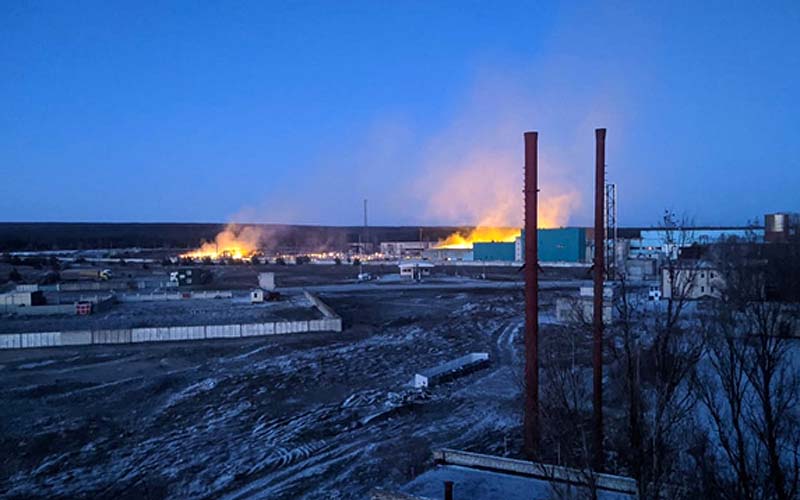Packaging in Ukraine – challenges, risks and recovery. We have to say a thanks to Ms. Veronika Khalaydzhi, Ph.D., and Mr. Valerii Kryvoshei, Ph.D., from Club Packagers, Ukraine for informing our readers about the situation of the packaging industry in Ukraine by their guest article.
The history of the modern packaging market in Ukraine goes back just over 30 years. Before this, the country, which has part of the Soviet Union, has “ruled” by a shortage of goods, food and drinks. Which hampered the development of packaging. There was no information about packaging products either in reference books or in state statistics bodies. Until the 1990s, the economic system itself denied competition between products on the market. Everything that has produced has consumed without advertising or packaging.
When the Ukrainian economy began to show the first signs of market relations, and goods began to compete and “search” for their consumers, then at first, spectacular and, over time, effective packaging became an important competitive factor. But over the past 1.5 years, as a result of russia’s war in Ukraine, the country’s economy, and with it the packaging industry, received a devastating blow. With which it is difficult to compare losses in the economy from natural anomalies, economic crises, and epidemics like Covid-19. This article is about the metamorphoses of the development and restoration of the Ukrainian packaging industry.
Packaging in Ukraine until February 24, 2022
The Ukrainian packaging industry began to emerge in the mid-90s of the last century with, at the same time, its own characteristics, patterns and trends. Ukraine, like many European countries, has doomed (at least in the near future) to import energy resources and many types of raw materials. Which can only be paid for by having sufficient exports of its products. Along with metallurgical and chemical products, food products can and should become an important part of Ukrainian exports. For its production and export, Ukraine has unique natural conditions, experience and human resources. Moreover, these products are environmentally friendly. In the early 1990s, it lacked modern, attractive and effective packaging.
The solution to this problem, on the one hand, made Ukrainian-made food products competitive in the markets of other countries. And on the other, provoked the development of the packaging industry in the country. After a sharp decline in the early 1990s, the Ukrainian market gradually began to become saturated with domestically produced food products. The share of which in some sectors began to reach 70-80%. This has facilitated by the development in Ukraine of modern methods of processing food and drinks to increase their shelf life.
Positive and negative trends
The use of effective packaging materials, modern types of packaging, technologies and equipment for their production. This was a response to the increasing competition of these products on the Ukrainian market. At the same time, both positive and negative trends in economic development have emerged. The population from rural areas moved to cities, the total population in the country decreased every yea.
The structure of retail trade changed – supermarkets began to appear, in which special attention has paid to consumer and transport packaging of products. The main tendency of the market economy began to manifest itself to a greater extent – the predominance of the marketing ideology (to satisfy the buyer by selling the products he needs). Which replaced the ideology of producing products regardless of their demand in the market. This led to an increase in packaging consumption per capita, which by the end of 2020 amounted to 80-85 kg per year.
This is less than the European average. However, the population bought most food products in modern packaging. By this time, the number of companies producing packaging materials and packaging in Ukraine exceeded 500 with about 100,000 employees (Table). For example, only 90–95 thousand tons of PET bottles for drinks in Ukraine have produced annually (Fig. 1). Transport containers from corrugated cardboard – 700–750 thousand tons (Fig. 2). Glass bottles and jars – 900–950 thousand tons (Fig. 3). Ukraine produced shrink and stretch films, thermoformed PP packaging, tin (Fig. 4) and aluminum cans and many other packaging products. All these enterprises had modern equipment of both foreign and domestic production for the production of packaging materials.
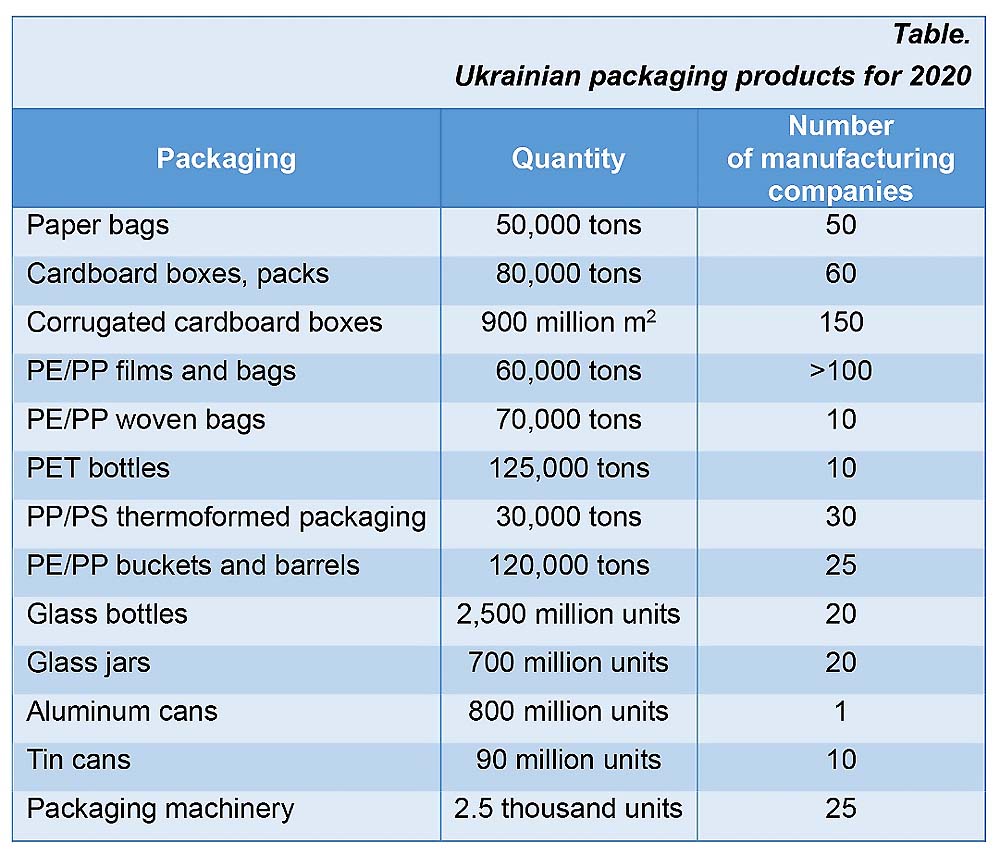
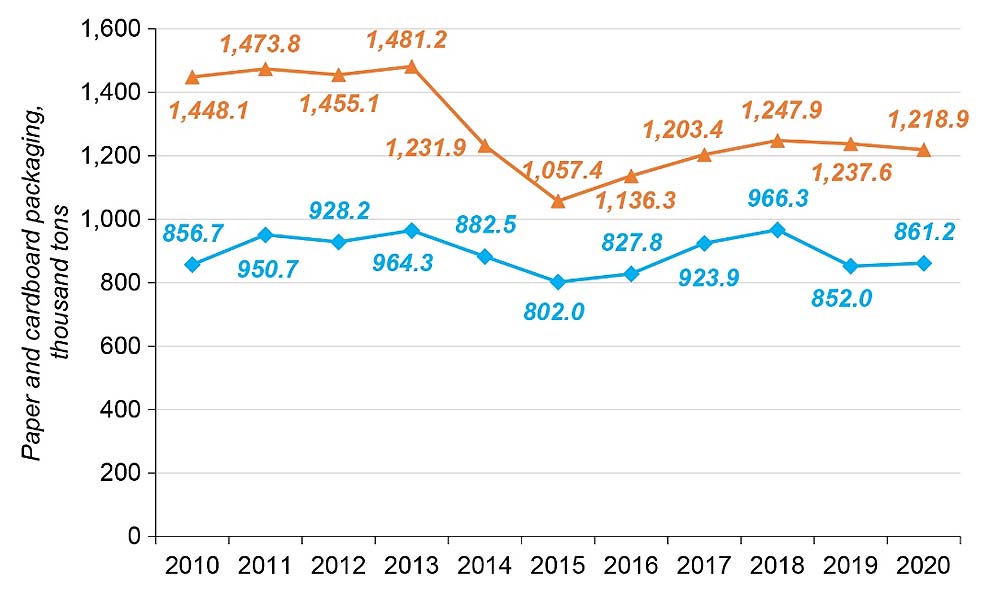
Fig. 1. Production (♦) and consumption (▲) of paper and cardboard packaging in Ukraine

Fig. 2. Structure of PET containers for drinks in Ukraine
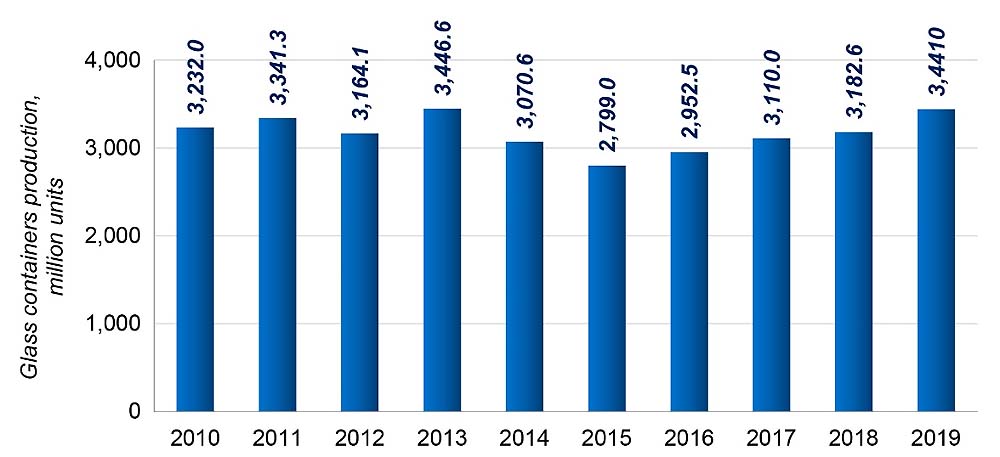
Fig. 3. Production of glass containers in Ukraine
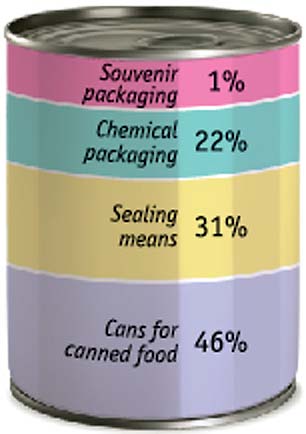
Fig. 4. Structure of tinplate packaging in Ukraine
Ukrainian packaging industry in the recent years
In recent years, the Ukrainian packaging industry has been operating in conditions of increased risks. Unpredictability of regulatory acts, corruption in government agencies, instability of the national currency, and lack of systemic reforms. I would like to draw attention to the technological and organizational risks for the packaging business. Firstly, almost all enterprises in the packaging industry operate almost entirely on imported raw materials. They import cellulose and even waste paper, paper and boxboard, almost all polymers and additives to them, aluminum foil, tin and other raw materials. The exception is manufacturers of glass bottles and jars, but they also chronically lack cullet, which also sometimes has to be imported.
Secondly, a state policy in the field of containers and packaging has not yet been formed in Ukraine, and there is no legislative framework. We can say, the packaging industry of Ukraine in the conditions of market relations has self-regulated and self-sufficient with information support from several professional associations. At the same time, following the main global trends, the production of packaging products in Ukraine is high-tech and focused on reducing material and energy resources.
As a result, over the past 15 years, the production and consumption of packaging in Ukraine has increased by 3–3.5 times. Specialists of many professions who take part in the development, production, testing and distribution of packaging in Ukraine (and this is several hundred thousand people) professionally know about many aspects of the creation and production of packaging materials, containers, packaging technologies and equipment. Today in Ukraine thousands of different types of packaging have produced from modern packaging domestic and foreign materials. Using technologies and equipment from world leaders.
Packing during the war
Already in the first weeks of the russian war in Ukraine, enterprises located in the cities where the fighting took place have stopped, and some have damaged. This applies to the eastern, southern and northern regions (Kyiv, Odesa, Kherson, Kharkiv, Sumy, Luhansk and Donetsk regions). There are productions of cardboard and corrugated cardboard, packaging made from these materials, plastic packaging, glass and aluminum packaging, and packaging equipment. Such powerful Ukrainian enterprises are leaders in the packaging industry as Vetropack Gostomel Glass Factory, Rubezhnoye Cardboard & Package Mill, manufacturer of plastic packaging Plast Box in Chernihiv and many others were completely or partially destroyed (Fig. 5).
Many enterprises in the east, north and south of Ukraine did not work for various reasons. In particular due to a lack of raw materials, spare parts for equipment and the lack of workers who went to defend Ukraine. In other areas, businesses tried to operate, but some had to reduce capacity. The problem with raw materials. Cellulose, waste paper, cullet, polyolefin polymers and PET has become critical for many. In addition, curfews, regular long-term air alarms and constant rocket attacks led to a decrease in working hours and productivity, complicating logistics. All this increased the cost of production. The demand for shelf-stable products, which have mainly packaged in complex barrier packaging, has increased. Most of the capacities for the production of packaging materials, various types of packaging, and packaging equipment, especially in cities where hostilities took place, have stopped and did not work.
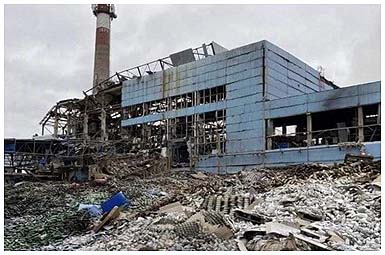
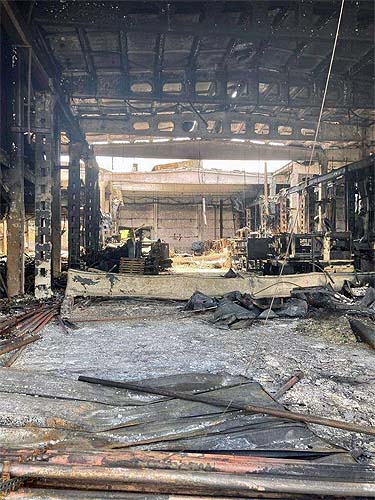
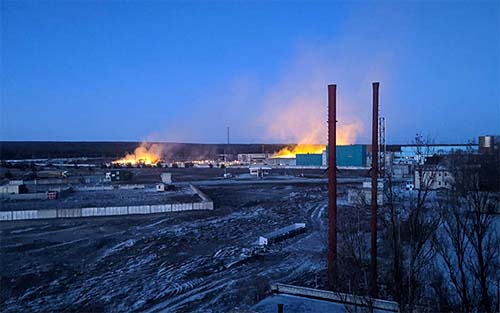
Lack of workers and raw materials
But already in early March 2022, some packaging plants began operating, trying to restore damaged capacity. They lacked raw materials, and some had to reduce production as their workers joined the army. However, packaging have already begun to reach food, pharmaceutical, personal care and other product manufacturers. As a result of the military actions of the russian occupiers in Irpin production facilities, warehouses with finished products have destroyed. The territory and office premises of Ukrainian companies have damaged. As a manufacturer of plastic products for agriculture, construction, packaging materials for food Planet Plastic. And companies Technocom – manufacturer of masterbatches, compounds and modifying admixtures for plastic packaging materials.
Resume production as soon as possible
But despite the huge losses and risks, the company management decided to resume production as soon as possible. Some time has passed and Planet Plastic began again to supply the country with urgently needed high-quality grain storage products, including greenhouse films. And Technocom high-quality dye concentrates (masterbatches) for the manufacture of packaging. Production of plastic packaging by the Polish company Plast Box in Chernihiv has destroyed. Its parent company sheltered Ukrainian workers and their families by providing jobs at its factories in Poland.
Continuing to actively work on the Ukrainian market, the Polish company continues to supply Ukrainian manufacturers of food, ink and varnish and other products with its products. The company’s management is confident in Ukraine’s victory and is considering plans to restore production in Chernihiv.
When Kherson was temporarily occupied by the russians, one of the two Danone factories in Ukraine, located in the city, stopped work, and workers have helped to evacuate. As a result of the fighting, several fermentation tanks and the roof of the administrative building have damaged. Then the company management relocated part of its production facilities to Poltava region, to another plant of the company. Thanks to this, the company resumed production of products such as Activia, Danone and Rostyshka. Coca-Cola Beverages Ukraine what’s in the village Velyka Dymerka close to Kyiv, suffered already at the beginning of the war. As a result of the shelling, a power plant has destroyed and disabled, and an office building and warehouse have partially damaged.
Food products to Ukraine from the Czech Republic and Poland
And although the plant’s production lines have not damaged. But has not possible to fully resume production immediately due to problems with the supply of raw materials and other components. The plant found itself in the russian occupation zone and did not operate for almost two months. At this time, supplies of Coca-Cola drinks to Ukraine from the Czech Republic and Poland have ensured. But already in mid-2022, production has restored and supplies of drinks. Have resumed to meet the needs of the Ukrainian market.
Elopak company in Fastiv near Kyiv has temporarily closed on February 24, 2022. But already in April it resumed the production and supply of packaging materials for food products. Needed at the front and in difficult areas occupied by Russia. Saving production from the consequences of the russian invasion, constant shelling and bombing. The Ukrainian company of the Belgian beer giant AB InBev moved the production of Chernigivske beer from Chernihiv to the city of Leuven (Flanders). The beer has produced in cans that depict a heart in the colors of the Ukrainian flag. And the inscription: “Everyone can help in humanitarian efforts for Ukraine.”
Packaging companies created a funds to help
Already in mid-May, Chernigivske beer appeared in Belgian supermarkets, bars and restaurants. This brand of beer could also be found on store shelves in Great Britain. The company sent all proceeds from sales of this beer to Ukrainian humanitarian organizations. And this is only a small fraction of such examples. Many packaging companies have created funds to help the population of Ukraine. Leader in cardboard packaging production Kyiv Cardboard and Paper Mill in Obukhiv. Located in the surrounding area Kyiv, created the “Cartonnyk” charitable foundation. Its employees helped with the logistics of humanitarian aid, delivering plant products and medical supplies to hospitals. Kyiv and Obukhiv finally, they baked and distributed bread to people. When in the first days of the war there were logistical problems with this.
Packaging in Ukraine after the war
Of course, the war affects the Ukrainian economy, including the packaging industry. It is difficult to assess such an impact now. It depends on many factors. Firstly, this is the duration of hostilities. Secondly, there is the level of destruction of packaging plants. The enemy today is destroying everything, including industrial enterprises. Today, many of them have damaged or completely destroyed.
After the war, it is necessary to check, analyze, conduct an expert assessment of each enterprise. And draw up a plan for their rebuilding. As a result of the war, today approximately 20% of the area of Ukraine is in danger. Under the threat of destruction. This poses a threat to the strategic goals of preserving biodiversity. Leads to a decrease in the potential for absorption of greenhouse gases, and intensifies the process of desertification. About 3 million hectares of forest in Ukraine have engulfed in military action.
More than 230 plants and factories have damaged
Due to the war, more than 4.6 million people in Ukraine have problems with access to drinking water. 160 thousand km2 of Ukrainian territory have contaminated with explosive objects. More than 230 plants and factories have damaged or destroyed due to the war. As a result of the destruction of buildings, a large amount of waste has generated containing ozone-depleting substances (insulation materials, insulating foam, etc.). By the way, even before the war in Ukraine there was a critical situation with waste. Due to the dominance of resource-intensive waste technologies in the national economy, approximately 500 million tons of waste have generated in Ukraine per year. But which 25% has recycled only.
Ukraine has developed a draft Plan for the rebuilding of Ukraine from the consequences of the war. Noteworthy is the section “Environmental Safety”, which identifies key challenges, opportunities and limitations. Key reforms include effective waste management. And operational goals include conducting damage audits and assessing damage to the environment. Introducing extended producer responsibility systems for packaging waste. And developing waste management infrastructure.
Green Recovery in Ukraine
As part of the UNIDO project “Industrial Capacity Development, Policy Advice and Diagnostics for a Green Recovery in Ukraine”. A program has developed to assess the immediate and long-term needs of the Ukrainian packaging industry. And develop a plan for its modernization. Of course, Ukraine needs special help after the war, when the packaging industry will be restored.
We hope that then packers around the world will provide Ukraine with the necessary assistance. It is necessary to create an international fund to help restore packaging enterprises in Ukraine. We think that many companies will join this help, and national packaging associations will initiate the creation of such a fund.
Veronika Khalaydzhi, Ph.D., and Mr. Valerii Kryvoshei, Ph.D., Club Packagers, Ukraine

